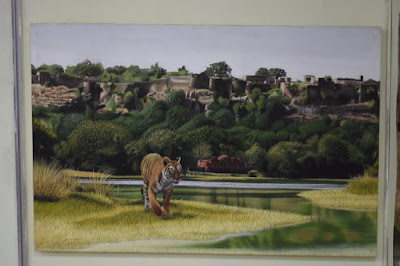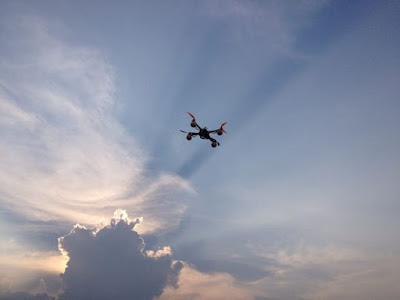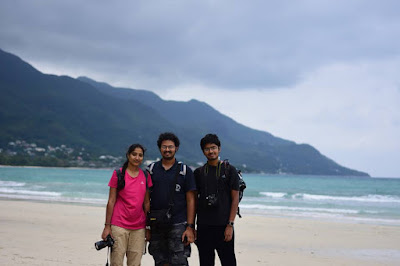 |
| Painting at some shop. |
Ranthambhore National Park ties with Bandhavgarh to the title of the tiger capital of India. It's said that it's much easier to spot the majestic cats in Ranthambhore. About 1500 sq Km of royal hunting grounds is part of the preserved dry deciduous forest. The best time to spot tigers is in the summer before the monsoon begins, when everything is dry. Visibility is at the maximum and animals flocks to the watering holes. The only problem is, it's the hottest season in the hottest state in India. Ranthambhore has long been a dream destination for me, reading about it in books and watching documentaries on it. It's one of the more accessible parks in India, with the town of Sawai Madhopur (also a railway junction) a few kilometres from it. The closest airport is Jaipur, which is about 2 hours away by train.
 |
| RTR-2 circuit. |
 |
| RTR-3 route. |
 |
| Srivani at Sawai Madhopur station |
We were planning for a mega wildlife trip early in 2016. Obvious candidates for consideration were Corbett, Ranthambhore, Sunderbans and Sasan Gir in India and Chitwan NP. in Nepal. We dropped Chitwan because it was going to be during the time of the Nepali monsoon. Corbett got dropped because of the ongoing Uttarakhand forest fires. We picked Ranthambhore over Sunderbans and Sasan Gir as we got a better deal on the travel. I used my JetPrivilege miles and we flew to Jaipur via Mumbai on 2nd June 2016. We caught a train from Jaipur to Sawai Madhopur at 9AM on 3rd June and reached Sawai Madhopur by about 11AM. We found our way to our hotel, Jain Residency. The owner, Sunil Jain, is a very courteous and principled man who made sure our trip happened seamlessly. Every day he would enquire about the wildlife we saw and filmed. He even presented us with a memento when we left.
 |
| T-39 with her cub. |
 |
| T-39 with her cub |
 |
| T-39 with her cub. |
We were in time on 3rd June to head to the afternoon safari. Jain Residency is less than a kilometre from the safari office. We figured out that after booking our safari tickets online, we have to go and pay the remaining money (guide fee etc.) at the booking office counter and get a ticket from him. After that, we have to identify our vehicle, driver and guide and prepare to leave. The issue is, nobody speaks anything but Hindi. Even the vehicle registration numbers are spoken in Hindi. So, one must know a bit of the language before heading here. Routes in Ranthambhore are numbered with the prefix, RTR, which stands for Ranthambhore Tiger Reserve. There are a total of 8 routes, out of which two are in the buffer zone (RTR-7 and RTR-8). These have relatively less wildlife but are splendid in their own way. They consist of ruins dotting the landscape with occasional peafowl or deer sightings. We learnt that RTR-6 went through sloth bear country and had the highest chances of sighting bears. All other routes have chances of sighting tigers, leopards, sloth bears and the big herbivores. We booked safaris on RTR-2 through 6. We took route RTR-2 on 3rd June. It was a great 3 hour safari and we had a very effective guide showing us the jungle. We saw tiger T-39 and her three cubs about half way into the route. They were playing around a water hole. Apart from the tigers, we encountered all sorts of herbivores and birds, Indian gazelles, spotted deer, sambar deer, nilgai, peafowl and drongos. We returned to the hotel by about 5:30 PM to finish the day with a scrumptious Rajasthani meal.
 |
| On RTR-6. |
 |
| On RTR-6. |
 |
| Baby spotted deer. |
 |
| Pacman, RTR-3. |
The next day was spent in two safaris back to back. The morning safari in RTR-6 was the most pleasant one. We spotted a male tiger a few minutes into the circuit. Our jeep got a puncture on the way back and the last 30 minutes of the ride was in the searing hot sun. The afternoon safari was in the hot sun of 2 PM. This was route RTR-3. RTR-3 is known for the lakes of Ranthambhore and consists of the sights which usually characterize Ranthambhore. It was so hot that we needed to cover our faces with a damp cloth. Even that would evaporate within a few minutes. The temperature reached the early fifties celsius. We managed to spot the young male, Pacman, at one of the lakes. He came to drink water and settled at the lake shore. He's an adolescent male tiger who recently got weened from his mother. He's out looking for a territory to claim and is constantly smelling trees for scent marks and marking them with his own scent. He also gets together with his sister, Arrowhead, who also got weened along with him. We happened to spot her a day later on RTR-4.
 |
| Pacman by the lake. |
 |
| Pacman, RTR-3. |
 |
| Nilgai. |
The fourth day started off in RTR-4. As expected, we found close to nothing there, save a few birds and tiger pug marks. We did not do a safari on this afternoon and instead went around the town to shop for novelty items. We visited a museum of natural history which was recently built in the town. This museum was a bit disappointing as it was only half built and had nothing more than tiger skulls, skins and stuffed animals. We also went around to local shops to see and buy souvenirs. We ended up purchasing a slab of marble with a tiger's eye painted on it. The first image in this blog is a canvas painting which was shot at the natural history museum.
 |
| Pacman, RTR-4. |
 |
| Pacman spraying his territory. |
 |
| Peafowl. |
The fifth day started off in RTR-4 (for the second time) as RTR-5 got merged with RTR-4. But it was anything but boring! We encountered Pacman again, in the first few minutes of the safari. We trailed him and he eventually lead us to his sister, Arrowhead. She was probably too shy to come out and we could only see her outline through the thick bushes. This was by far the most exciting part of the whole trip. I managed to click amazing shots of Pacman, which remain my best shots from Ranthambhore. The evening safari was on the RTR-2 route. We ended up finding little on the route, but we were informed that we missed T-39 and her cubs by a few minutes at a watering hole. However, on the way out, we crossed paths with the most elusive cat of them all, the Indian leopard. This remains as one of only two times that I managed to spot leopards in the wild. There are probably ten times more leopards than all other big cats combined. Nobody knows exactly how many leopards exist in the wild as they are way too elusive to be counted in a census. In Indian cities such as Mumbai, leopards even come onto the streets and scavenge for food. In fact, we are headed to Yala National Park, Sri Lanka, in about a month from now just to observe and film leopards. Sri Lankan leopards are much less secretive than their Indian cousins and Yala is known for housing bold leopards which don't hide from being seen and are out in the open even in broad daylight.
 |
| The Indian leopard, RTR-2. |
 |
| Langur monkey troop. |
 |
| Scops owl. |
About half the safaris we did were on canters (open-top buses) and the other half on Maruti Gypsys. Overall, with about 6 individual tigers being spotted, this trip has been an immense success. We observed the intricacies of the Indian bush. The cooperation between langurs and deer and the dance of the peacock. The warning calls of sambar deer, alerting everyone to a tiger's presence. The sheer majesty of a male tiger on the prowl and how the jungle clears the way for him. I do hope to see a better future for the country's tigers. It is, after all, our national animal!
 |
| RTR-6 route. |
 |
| Mugger crocodile. |
|
|
























Comments
Post a Comment